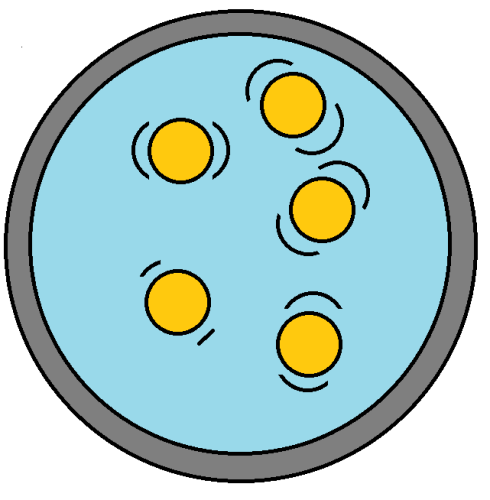
Can you guess what the above image represents? Spiky bouncy balls? Dog toys? Viruses?
It is actually grains of pollen! These grains are around 10,000 times larger than a molecule of water, and they led to a very interesting discovery about particles when Robert Brown decided to look at them under a microscope.

What is Brownian motion?
Brownian motion is the observation that pollen grains will continuously move, randomly when they are suspended in water. The grains never stop moving, and it is impossible to predict their direction, as it follows no pattern. This doesn't just have to be grains of pollen - any particle inside a fluid will experience this type of motion. For example, you can observe smoke particles in air, and the same effect is seen.

The diagram above shows the pollen grains vibrating in all directions and at different speeds. This is what Robert Brown would have seen. Notice the water molecules themselves are too small to be seen under a microscope.
What does Brownian motion tell us about particles?
The fact that the pollen was constantly 'dancing around' means that something must have been making it do that. (Pollen particles, being solid, do not move randomly on their own). It must have been the water molecules colliding with the pollen that was making them have this motion.
So, the observation leads to an important conclusion: particles in a fluid move randomly, in all directions, and will never stop moving.
Can it be sped up or slowed down? How about stopped?
The particles are moving because they have a temperature, meaning they possess energy. In order to make Brownian motion occur faster (i.e. to see faster-moving pollen), you would just have to increase the temperature of the water. This would give the water molecules more energy and they would collide more frequently with the pollen.
The opposite effect would slow down the motion: decreasing the temperature would slow everything down and you would see slower-moving pollen.
You can only completely stop particles from moving if you reduce the temperature to -273ºC. This is called absolute zero, and it is the temperature at which particles will have no energy, and they will therefore stop moving. However, this temperature has never been achieved on planet Earth. In fact, scientists are not even sure that the very deepest, darkest, emptiest regions of outer space can reach this temperature. So, as far as we are concerned, particles will always be in motion due to having a temperature.

Let's have a go at some questions on this now and remember that you can come back to this page at any point by clicking on the red help button on the screen.








